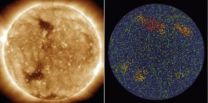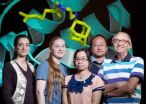(Press-News.org) Like a balloon bobbing along in the air while tied to a child's hand, a tracer has been found in the sun's atmosphere to help track the flow of material coursing underneath the sun's surface.
New research that uses data from NASA's Solar Dynamics Observatory, or SDO, to track bright points in the solar atmosphere and magnetic signatures on the sun's surface offers a way to probe the star's depths faster than ever before. The technique opens the door for near real-time mapping of the sun's roiling interior – movement that affects a wide range of events on the sun from its 22-year sunspot cycle to its frequent bursts of X-ray light called solar flares.
"There are all sorts of things lurking below the surface," said Scott McIntosh, first author of a paper on these results in the April 1, 2014, issue of the Astrophysical Journal Letters. "And we've found a marker for this deep rooted activity. This is kind of a gateway to the interior, and we don't need months of data to get there."
One of the most common ways to probe the sun's interior is through a technique called helioseismology in which scientists track the time it takes for waves – not unlike seismic waves on Earth -- to travel from one side of the sun to the other. From helioseismology solar scientists have some sense of what's happening inside the sun, which they believe to be made up of granules and super-granules of moving solar material. The material is constantly overturning like boiling water in a pot, but on a much grander scale: A granule is approximately the distance from Los Angeles to New York City; a super-granule is about twice the diameter of Earth.
Instead of tracking seismic waves, the new research probes the solar interior using the Helioseismic Magnetic Imager on NASA's Solar Dynamics Observatory, or SDO, which can map the dynamic magnetic fields that thread through and around the sun. Since 2010, McIntosh has tracked the size of different magnetically-balanced areas on the sun, that is, areas where there are an even number of magnetic fields pointing down in toward the sun as pointing out. Think of it like looking down at a city from above with a technology that observed people, but not walls, and recording areas that have an even number of men and women. Even without seeing the buildings, you'd naturally get a sense for the size of rooms, houses, buildings, and whole city blocks – the structures in which people naturally group.
The team found that the magnetic parcels they mapped corresponded to the size of granules and supergranules, but they also spotted areas much larger than those previously noted -- about the diameter of Jupiter. It's as if when searching for those pairs of men and women, one suddenly realized that the city itself and the sprawling suburbs was another scale worth paying attention to. The scientists believe these areas correlate to even larger cells of flowing material inside the sun.
The researchers also looked at these regions in SDO imagery of the sun's atmosphere, the corona, using the Atmospheric Imaging Assembly instrument. They noticed that ubiquitous spots of extreme ultraviolet and X-ray light, known as brightpoints, prefer to hover around the vertices of these large areas, dubbed g-nodes.
"Imagine a bunch of helium balloons with weights on them," said Robert Leamon, co-author on the paper at Montana State University in Bozeman and NASA Headquarters in Washington. "The weights get carried along by the motions at the bottom. We can track the motion of the helium balloons floating up high and that tells us what's happening down below."
By opening up a way to peer inside the sun quickly, these techniques could provide a straightforward way to map the sun's interior and perhaps even improve our ability to forecast changes in magnetic fields that can lead to solar eruptions.
INFORMATION:
SDO is the first mission in NASA's Living with a Star program to explore aspects of the connected sun-Earth system that directly affect life and society. For more information about SDO and its mission, visit:
http://www.nasa.gov/sdo
Bright points in sun's atmosphere mark patterns deep in its interior
2014-04-17
ELSE PRESS RELEASES FROM THIS DATE:
Lab researcher discovers the green in Greenland
2014-04-17
At one point in history, Greenland was actually green and not a country covered in ice.
An international team of researchers, including a scientist from Lawrence Livermore National Laboratory, has discovered that ancient dirt in Greenland was cryogenically frozen for millions of years under nearly two miles of ice.
More than 2.5 million years ago. Greenland looked like the green Alaskan tundra, before it was covered by the second largest body of ice on Earth.
The ancient dirt under the Greenland ice sheet helps to unravel an important mystery surrounding climate change: ...
Multitarget TB drug could treat other diseases, evade resistance
2014-04-17
CHAMPAIGN, Ill. — A drug under clinical trials to treat tuberculosis could be the basis for a class of broad-spectrum drugs that act against various bacteria, fungal infections and parasites, yet evade resistance, according to a study by University of Illinois chemists and collaborators.
Led by U. of I. chemistry professor Eric Oldfield, the team determined the different ways the drug SQ109 attacks the tuberculosis bacterium, how the drug can be tweaked to target other pathogens from yeast to malaria – and how targeting multiple pathways reduces the probability of pathogens ...
Study recalculates costs of combination vaccines
2014-04-17
CHAMPAIGN, Ill. — One of the most popular vaccine brands for children may not be the most cost-effective choice. And doctors may be overlooking some cost factors when choosing vaccines, driving the market toward what is actually a more expensive option, according to a new study by University of Illinois researchers.
"The choice of vaccines to administer can be driven by numerous factors," says Sheldon H. Jacobson, a co-author of the study and a professor of computer science and of mathematics at the U. of I. "In an environment where vaccines are under growing public scrutiny, ...
Feinstein Institute researcher publishes new perspective on sepsis
2014-04-17
MANHASSET, NY – In a review published in the April issue of Immunity, Kevin J. Tracey, MD, president of The Feinstein Institute for Medical Research, says it's time to take a fresh look at the medical community's approach to treating sepsis, which kills millions worldwide every year, including more than 200,000 Americans.
Sepsis occurs when molecules released into the bloodstream to fight an injury or infection trigger inflammation throughout the body. Inflammation is necessary for maintaining good health – without inflammation, wounds and infections would never be ...
McCullers reviews influenza, bacterial superinfections in Nature Reviews Microbiology
2014-04-17
Le Bonheur Children's Hospital Pediatrician-in-Chief Jon McCullers, MD, was recently invited to submit a review in the April issue of Nature Reviews Microbiology, one of the world's foremost scientific publications. Dr. McCullers, a world-renowned infectious disease specialist, and chair of the Department of Pediatrics at the University of Tennessee Health Science Center, analyzed the epidemiology and microbiology of co-infections during the 1918, 1957 and 1968 pandemics, as well as more recent 2009 novel H1N1 pandemic.
He reviewed the co-pathogenesis of influenza viruses ...
Building 'smart' cell-based therapies
2014-04-17
A Northwestern University synthetic biology team has created a new technology for modifying human cells to create programmable therapeutics that could travel the body and selectively target cancer and other sites of disease.
Engineering cell-based, biological devices that monitor and modify human physiology is a promising frontier in clinical synthetic biology. However, no existing technology enabled bioengineers to build such devices that sense a patient's physiological state and respond in a customized fashion.
"The project addressed a key gap in the synthetic biology ...
Live cell imaging reveals distinct alterations of subcellular glutathione potentials
2014-04-17
In the April issue of Experimental Biology and Medicine a multidisciplinary research team led by Drs. Rex Gaskins and Paul Kenis in the Institute of Genomic Biology (IGB) on the campus of the University of Illinois Urbana-Champaign describe their recent work on subcellular redox homeostasis. Intracellular reduction-oxidation reactions underlie a variety of cell functions including energy metabolism, signaling, and transcriptional processes. Due to these crucial roles in regulating normal cellular behavior, redox status has been recognized as a key area of biological research ...
The ilk of human kindness
2014-04-17
Researchers at the University of California, San Diego School of Medicine report that older women, plucky individuals and those who have suffered a recent major loss are more likely to be compassionate toward strangers than other older adults.
The study is published in this month's issue of the International Journal of Geriatric Psychiatry.
Because compassionate behaviors are associated with better health and well-being as we age, the research findings offer insights into ways to improve the outcomes of individuals whose deficits in compassion put them at risk for becoming ...
First potentially habitable Earth-sized planet confirmed by Gemini and Keck observatories
2014-04-17
VIDEO:
This animation depicts Kepler-186f, the first validated Earth-size planet orbiting a distant star in the habitable zone -- a range of distances from a star where liquid water might pool...
Click here for more information.
"What makes this finding particularly compelling is that this Earth-sized planet, one of five orbiting this star, which is cooler than the Sun, resides in a temperate region where water could exist in liquid form," says Elisa Quintana of the SETI Institute ...
Patients with rare lung disease face agonizing treatment dilemma
2014-04-17
MAYWOOD, Il. (April 17, 2014) – Doctors who treat patients with a severe and progressive respiratory disease called lymphangioleiomyomatosis (LAM) can face an agonizing treatment decision.
The drug sirolimus can slow progression of the disease and help relieve shortness of breath. But some patients eventually may need lung transplants, and sirolimus can cause potentially fatal complications following transplantation.
"It's a terrible situation," said pulmonologist Dr. Daniel Dilling, medical director of Loyola University Medical Center's LAM Clinic and Lung Transplantation ...


